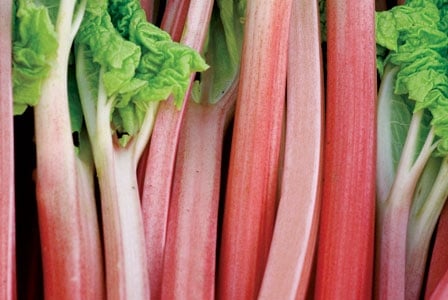
Despite rhubarb\’s reputation as merely a pie filling, it\’s actually a versatile vegetable that lends itself to healthy salads, stir-fries, and desserts.
If you think of rhubarb merely as the “pie plant,” or a natural remedy for constipation, you’re underestimating this versatile, health-enhancing member of the buckwheat family. Although often mistaken as a fruit due to its common appearance in desserts, rhubarb is actually a vegetable with a long history of both medicinal and culinary use.
Rhubarb (Rheum rhabarbarum), which favours cooler climates, originated in Asia over 5,000 years ago, where it was initially cultivated for its medicinal qualities. Folklore maintains that Ben Franklin was responsible for bringing the tart vegetable to American shores in the late 1700s. However, it wasn’t until the 19th century that rhubarb was grown for culinary purposes in Britain and North America.
Medicinal uses
Rhubarb has been used for centuries in traditional Chinese medicine and remains one of the most widely used herbs in this modality. The dried root and rhizomes of the plant are used to treat a variety of ailments, including constipation, liver and gallbladder complaints, poor blood circulation, and senility.
Recently, modern research has validated its medicinal use by uncovering several beneficial compounds in rhubarb that can fight cancer, lower cholesterol, reduce inflammation, lower blood pressure, and protect eye and brain health. Among these compounds are anthraquinones, plant chemicals scientists have found to be particularly potent anticancer agents. Emodin, the most abundant anthraquinone in rhubarb, has been shown to fight cancer in three ways: it inhibits cellular proliferation, induces apoptosis (cell death) in cancer cells, and prevents metastasis.
In addition, rhubarb also houses the powerful antioxidants resveratrol, lutein, and zeaxanthin and delivers good amounts of B-complex vitamins, vitamins K and C, calcium, potassium, and manganese.
Although we tend to limit this über-healthy vegetable to the pie dish in North America, it actually has many culinary uses. From muffins to chutneys, salads to stir-fries, rhubarb can impart flavour and health to almost any dish.
Rhubarb 101
- Don’t eat the leaves! Rhubarb leaves are toxic—they contain high levels of oxalic acid and may contain poisonous glycosides.
- The redder the stalk, the sweeter the rhubarb. Avoid stalks that have brown spots or appear too green.
- Clean rhubarb by wiping it with a damp cloth. Do not rinse it in water, as this will split and wilt the stalks. Washed and dried rhubarb will keep in the refrigerator for three to four days.
- Peeling rhubarb is unnecessary; simply remove stringy pieces by pulling them from the stalk.
- Researchers have identified over 40 polyphenol compounds in rhubarb, including anthocyanins, the disease-fighting pigments that make blueberries so nutritious.
- Cooking rhubarb actually increases its polyphenol content and overall antioxidant capacity.
Recipes
- Rhubarb Buttermilk Muffins
- Roasted Rhubarb and Beet Salad
- Sweet Chicken Stir-Fry
- Wheat-Free Rhubarb-Strawberry Crumble
The oat debate
Although current government guidelines state that no product containing oats can be labelled as gluten-free, Health Canada recognizes that most people with celiac disease can safely consume pure and uncontaminated oats, which may contain no more than 20 parts per million of gluten. Those with celiac disease are urged to use caution and follow up with their health care practitioners when reintroducing oats into the diet.

